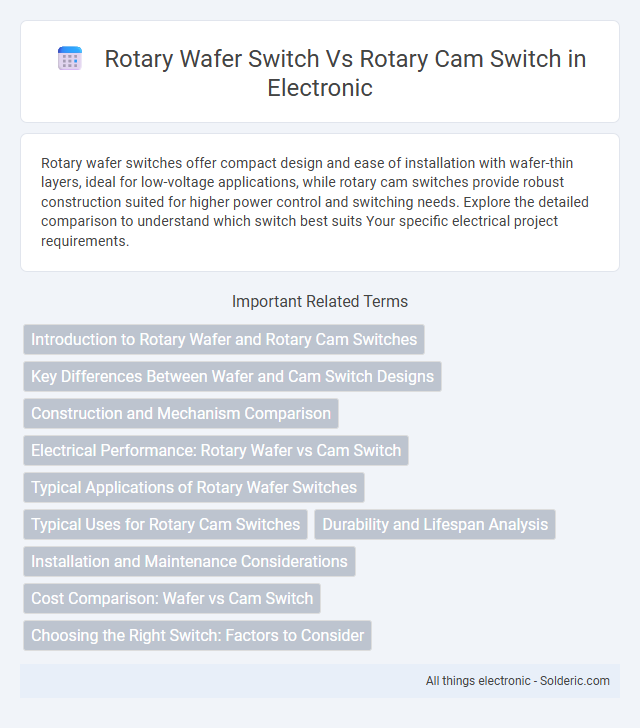Rotary wafer switches offer compact design and ease of installation with wafer-thin layers, ideal for low-voltage applications, while rotary cam switches provide robust construction suited for higher power control and switching needs. Explore the detailed comparison to understand which switch best suits Your specific electrical project requirements.
Comparison Table
| Feature | Rotary Wafer Switch | Rotary Cam Switch |
|---|---|---|
| Switching Mechanism | Multiple wafers rotate simultaneously to change circuits | Cam rotates to mechanically engage contacts for circuit switching |
| Application | Low to medium voltage control, signal switching | High power circuits, motor control, industrial applications |
| Contact Type | Fixed contacts on wafers | Cam-operated spring contacts |
| Durability | Moderate, suitable for less frequent switching | High, designed for heavy-duty and frequent switching |
| Number of Positions | Typically limited, depends on wafer layers | Multiple positions available via cam design |
| Size | Compact and lightweight | Bulkier due to mechanical cam assembly |
| Cost | Generally lower | Higher due to robust construction |
| Maintenance | Minimal, but less robust contacts | Requires periodic inspection for contact wear |
Introduction to Rotary Wafer and Rotary Cam Switches
Rotary wafer switches feature stacked wafer-like contacts allowing multiple circuits to be controlled through a single switch shaft, commonly used in compact electronic devices for versatile circuit selection. Rotary cam switches utilize a cam mechanism to mechanically engage or disengage circuits, providing robust and reliable switching ideal for industrial applications requiring high durability and precise control. Both switches serve to manage multiple electrical circuits but differ significantly in construction, operation, and suitability based on application needs.
Key Differences Between Wafer and Cam Switch Designs
Rotary wafer switches feature a compact, modular design with multiple isolation layers acting like wafers, allowing for high flexibility in circuit configurations and easy mounting in tight spaces. Rotary cam switches use a cam mechanism to physically open or close contacts, providing robust switching with tactile feedback and suitability for higher current applications. Understanding these key differences helps you select the right switch type based on space constraints, operational durability, and specific electrical requirements.
Construction and Mechanism Comparison
Rotary wafer switches consist of thin, flat wafers stacked on a common shaft, with discrete contact points that rotate to open or close circuits, allowing compact and modular designs ideal for multi-position switching. Rotary cam switches feature a cam mechanism that mechanically moves contacts along a predefined path, offering higher durability and precise switching suitable for heavy-duty applications. The wafer switch's lighter construction enables easy customization, while the cam switch's robust build ensures reliable performance under demanding electrical loads.
Electrical Performance: Rotary Wafer vs Cam Switch
Rotary wafer switches offer precise, low-voltage switching with minimal contact resistance, making them ideal for signal-level applications, while rotary cam switches handle higher currents and voltages efficiently due to their robust mechanical design and multiple contact configurations. Electrical performance of wafer switches excels in compact circuits requiring rapid switching cycles, whereas cam switches provide reliable power distribution and control in industrial environments. Your choice depends on the electrical load and durability requirements, with cam switches preferred for heavy-duty applications and wafer switches suited for delicate, low-power control tasks.
Typical Applications of Rotary Wafer Switches
Rotary wafer switches are commonly used in audio equipment, instrumentation, and control panels where low voltage signal switching is required. These switches provide precise multi-position selection and are ideal for tuning circuits, mode selection, and function switching in electronic devices. Their compact design and reliable operation make them suitable for consumer electronics and communication equipment.
Typical Uses for Rotary Cam Switches
Rotary cam switches are commonly used in industrial machinery for controlling power circuits and selecting operational modes due to their reliable multi-position function. These switches enable seamless control of motor starter circuits, generator sets, and machine tool operations, offering precise position feedback and high current handling capacity. Your equipment benefits from their durability in demanding environments where consistent performance and safety are critical.
Durability and Lifespan Analysis
Rotary wafer switches typically feature multiple thin wafer-like layers that can wear down quicker under heavy use, resulting in a shorter lifespan compared to rotary cam switches. Rotary cam switches use robust cam mechanisms designed to provide reliable and precise switching over millions of cycles, ensuring superior durability in industrial applications. Choosing the right switch for your project depends on the expected operational frequency and environmental conditions to maximize durability and lifespan.
Installation and Maintenance Considerations
Rotary wafer switches offer straightforward installation with compact design, making them ideal for applications requiring minimal panel space and simple wiring. Rotary cam switches, while bulkier, provide robust durability and are easier to maintain due to their modular components and accessible contact assemblies. Maintenance for rotary cam switches involves periodic lubrication and contact inspection, whereas rotary wafer switches demand less frequent attention but may require complete replacement if internal contacts fail.
Cost Comparison: Wafer vs Cam Switch
Rotary wafer switches generally offer a lower cost compared to rotary cam switches due to their simpler construction and fewer moving parts. Cam switches provide enhanced durability and greater switching reliability, which justifies their higher price in applications demanding frequent or heavy-duty operation. Cost-effectiveness of wafer switches suits budget-sensitive projects, while cam switches deliver long-term value in industrial environments with rigorous performance requirements.
Choosing the Right Switch: Factors to Consider
When choosing between a rotary wafer switch and a rotary cam switch, consider the application's current rating and switching frequency, as wafer switches often suit low-current, signal-level uses, while cam switches handle higher power loads. Evaluate the required number of poles and positions, as cam switches provide more robust mechanical configurations for complex circuits, enhancing durability and reliability in industrial environments. Your selection should also factor in space constraints and ease of installation, with wafer switches offering compact designs ideal for limited spaces.
Rotary wafer switch vs Rotary cam switch Infographic

 solderic.com
solderic.com